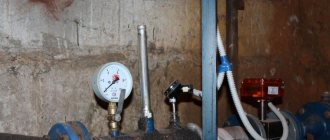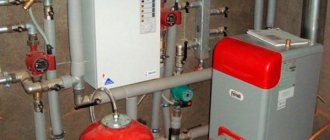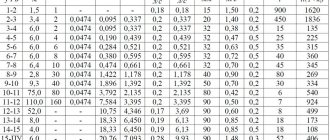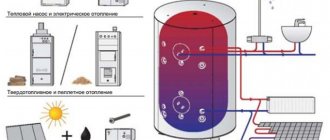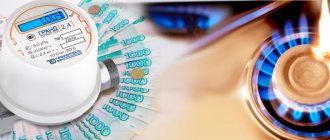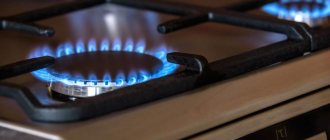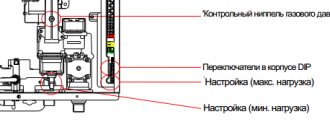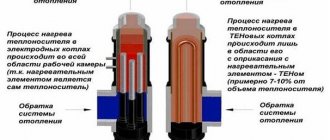Calculation of hot water by gcal per m3
Calculation of the cost of thermal energy for heating 1 sq.
meters of total area in 2021: Heating consumption standard * Thermal energy tariff = cost of thermal energy for heating 1 sq. m:
January-April 0.0366 Gcal/sq. m * 1197.50 rub/Gcal = 43.8285 rub/sq.m.
May 0.0122 Gcal/sq. m * 1197.50 rub./Gcal = 14.6095 rub./sq.m
October 0.0322 * 1211.33 rubles/Gcal = 39.0048 rubles/sq.m.
November-December 0.0366 Gcal/sq. m * 1211.33 rub./Gcal = 44.3347 rub./sq.m
Calculation of the cost of service for hot water supply per person in 2021:
DHW consumption standard * Heat energy tariff = cost of DHW service per 1 person
An example of calculating the cost of a hot water supply service for 1 person with a fully equipped apartment (from 1 to 10 storeys, equipped with a sink, washbasin, bathtub 1500-1700 mm long with shower) in the absence of hot water meters:
January-June 0.2120 Gcal/per person. per month *1197.50 rub./Gcal = 253.87 rub./person.
July-December 0.2120 Gcal/per person. per month *1211.33 rub./Gcal = 256.80 rub./person.
Calculation of the cost of service for hot water supply using a domestic hot water meter in 2021:
The standard thermal energy consumption for heating is 1 cubic meter. m of water * Tariff for thermal energy = cost of service for heating 1 cubic meter. m
January – June 0.0467 Gcal/cub. m * 1197.50 rub./Gcal = 55.9233 rub./cubic. m.
July-December 0.0467 Gcal/cu.m. m * 1211.33 rub./Gcal = 56.5691 rub./cubic. m
2016
Calculation of the cost of thermal energy for heating 1 sq. meters of total area in 2021:
Heating consumption standard * Thermal energy tariff = cost of thermal energy for heating 1 sq. m:
January-April 0.0366 Gcal/sq. m * 1170.57 rub/Gcal = 42.8429 rub/sq.m.
May 0.0122 Gcal/sq. m * 1170.57 rub./Gcal = 14.2810 rub./sq.m
October 0.0322 * 1197.50 rubles/Gcal = 38.5595 rubles/sq.m.
November-December 0.0366 Gcal/sq. m * 1197.50 rub./Gcal = 43.8285 rub./sq.m
Calculation of the cost of service for hot water supply per person in 2021:
DHW consumption standard * Heat energy tariff = cost of DHW service per 1 person
An example of calculating the cost of a hot water supply service for 1 person with a fully equipped apartment (from 1 to 10 storeys, equipped with a sink, washbasin, bathtub 1500-1700 mm long with shower) in the absence of hot water meters:
January-June 0.2120 Gcal/per person. per month *1170.57 rub./Gcal = 248.16 rub./person.
July-December 0.2120 Gcal/per person. per month *1197.50 rub./Gcal = 253.87 rub./person.
Calculation of the cost of service for hot water supply using a domestic hot water meter in 2021:
The standard thermal energy consumption for heating is 1 cubic meter. m of water * Tariff for thermal energy = cost of service for heating 1 cubic meter. m
January – June 0.0467 Gcal/cub. m * 1170.57 rub./Gcal = 54.6656 rub./cubic. m
July-December 0.0467 Gcal/cu.m. m * 1197.50 rub./Gcal = 55.9233 rub./cubic. m
2015
Calculation of the cost of thermal energy for heating 1 sq. meters of total area in 2015:
Heating consumption standard * Thermal energy tariff = cost of thermal energy for heating 1 sq. m:
January-April 0.0366 Gcal/sq. m * 990.50 rub./Gcal = 36.2523 rub./sq.m
May 0.0122 Gcal/sq. m * 990.50 rub./Gcal = 12.0841 rub./sq.m
October 0.0322 * 1170.57 rubles/Gcal = 37.6924 rubles/sq.m.
November-December 0.0366 Gcal/sq. m * 1170.57 rub./Gcal = 42.8429 rub./sq.m
Calculation of the cost of hot water supply services per person in 2015:
DHW consumption standard * Heat energy tariff = cost of DHW service per 1 person
An example of calculating the cost of a hot water supply service for 1 person with a fully equipped apartment (from 1 to 10 storeys, equipped with a sink, washbasin, bathtub 1500-1700 mm long with shower) in the absence of hot water meters:
January-June 0.2120 Gcal/per person. per month *990.50 rub./Gcal = 209.986 rub./person.
July-December 0.2120 Gcal/per person. per month *1170.57 rub./Gcal = 248.1608 rub./person.
Calculation of the cost of service for hot water supply using a domestic hot water meter in 2015:
The standard thermal energy consumption for heating is 1 cubic meter.
m of water * Tariff for thermal energy = cost of service for heating 1 cubic meter. m
January – June 0.0467 Gcal/cub. m * 990.50 rub./Gcal = 46.2564 rub./cubic. m
July-December 0.0467 Gcal/cu.m. m * 1170.57 rub./Gcal = 54.6656 rub./cubic. m
year 2014
Calculation of the cost of thermal energy for heating 1 sq. meters of total area in 2014:
Heating consumption standard * Thermal energy tariff = cost of thermal energy for heating 1 sq. m:
January-April 0.0366 Gcal/sq. m * 934.43 rub./Gcal = 34.2001 rub./sq.m
May 0.0122 Gcal/sq. m * 934.43 rub./Gcal = 11.4000 rub./sq.m
October 0.0322 Gcal/sq. m * 990.50 rub./Gcal = 31.8941 rub./sq. m
November – December 0.0366 Gcal/sq. m * 990.50 rub./Gcal = 36.2523 rub./sq.m
Calculation of the cost of service for hot water supply per 1 person in 2014:
DHW consumption standard * Heat energy tariff = cost of DHW service per 1 person
An example of calculating the cost of a hot water supply service for 1 person with a fully equipped apartment (from 1 to 10 storeys, equipped with a sink, washbasin, bathtub 1500-1700 mm long with shower) in the absence of hot water meters:
January-June 0.2120 Gcal/per person. per month * 934.43 rub./Gcal = 198.0991 rub./person.
July – December 0.2120 Gcal/per person. per month * 990.50 rub./Gcal = 209.986 rub./person.
Calculation of the cost of service for hot water supply using a domestic hot water meter in 2014:
The standard thermal energy consumption for heating is 1 cubic meter. m of water * Tariff for thermal energy = cost of service for heating 1 cubic meter. m
January – June 0.0467 Gcal/cub. m * 934.43 rub./Gcal = 43.6378 rub./cubic. m
July – December 0.0467 Gcal/cubic. m * 990.50 rub./Gcal = 46.2564 rub./cubic. m
year 2013
Calculation of the cost of thermal energy for heating 1 sq. meters of total area in 2013:
Heating consumption standard * Thermal energy tariff (supplier MUP "ChKTS" or Mechel-Energo LLC) = The cost of thermal energy for heating 1 sq. m
- January-April 0.0366 Gcal/sq. m * 851.03 rub./Gcal = 31.1477 rub./sq.m
- May 0.0122 Gcal/sq. m *851.03 rub./Gcal =10.3826 rub./sq.m
- October 0.0322 Gcal/sq. m * 934.43 rub./Gcal = 30.0886 rub./sq. m
- November – December 0.0366 Gcal/sq. m * 934.43 rub./Gcal = 34.2001 rub./sq.m
Gigacalorie formula
Having considered the definition of the value being studied, it is worth finally finding out how to calculate how many gigacalories are used to heat a room during the heating season.
For especially lazy people on the Internet, there are a lot of online resources where specially programmed calculators are presented. All you have to do is enter your numerical data - and they themselves will calculate the number of gigacalories consumed.
However, it would be nice to be able to do this yourself. There are several formula options for this. The simplest and most understandable among them is the following:
Thermal energy (Gcal/hour) = (M 1 x (T 1 -T xv)) - (M 2 x (T 2 -T xv)) / 1000, where:
- M 1 is the mass of the heat transfer substance that is supplied through the pipeline. Measured in tons.
- M 2 is the mass of the heat transfer substance returning through the pipeline.
- T 1 - coolant temperature in the supply pipeline, measured in Celsius.
- T 2 is the temperature of the coolant returning back.
- Тхв - temperature of the cold source (water). Usually equal to five because this is the minimum temperature of the water in the pipeline.
Gigacalorie and gigacalorie/hour: what is the difference
In addition to the fictitious value in question, receipts sometimes contain an abbreviation such as “Gcal/hour.” What does it mean and how does it differ from the usual gigacalorie?
This unit of measurement shows how much energy was used in one hour.
While just a gigacalorie is a measurement of heat consumed over an indefinite period of time. It depends only on the consumer what time frame will be indicated in this category.
The abbreviation Gcal/m3 is much less common. It means how many gigacalories need to be used to heat one cubic meter of a substance.
Calculation of liquefied gas consumption
Many boilers can run on liquefied gas. How profitable is this? What will be the consumption of liquefied gas for heating? All this can also be calculated. The technique is the same: you need to know either the heat loss or the power of the boiler. Next, we convert the required quantity into liters (units of measurement of liquefied gas), and, if desired, we count the number of required cylinders.
Let's look at the calculation using an example. Let the boiler power be 18 kW, respectively, the average heat demand is 9 kW/hour. When burning 1 kg of liquefied gas, we obtain 12.5 kW of heat . This means that to get 9 kW, you will need 0.72 kg (9 kW / 12.5 kW = 0.72 kg).
Next we consider:
- per day: 0.72 kg * 24 hours = 17.28 kg;
- per month 17.28 kg * 30 days = 518.4 kg.
Let's add a correction for the boiler efficiency. We need to look at each specific case, but let’s take 90%, that is, add another 10%, it turns out that the monthly consumption will be 570.24 kg.
Liquefied gas is one of the heating options
To calculate the number of cylinders, divide this figure by 21.2 kg (this is the average kg of gas in a 50 liter cylinder).

Mass of liquefied gas in various cylinders
In total, this boiler will require 27 liquefied gas cylinders. Calculate the cost yourself - prices vary in the regions. But don't forget about transportation costs. By the way, they can be reduced by making a gas holder - a sealed container for storing liquefied gas, which can be refilled once a month or less often - depending on the storage volume and demand.
Again, remember that this is just an approximate figure. In cold months, gas consumption for heating will be higher, in warm months it will be much less.
PS If it is more convenient for you to calculate the consumption in liters:
- 1 liter of liquefied gas weighs approximately 0.55 kg and, when burned, produces approximately 6500 kW of heat;
- There are about 42 liters of gas in a 50 liter cylinder.
How is the heat supply fee calculated?
If water supply for domestic needs is assessed using in-house metering devices or approved standards, then the payment for heat supply is calculated based on approved methods.

There are two options for accrual periods:
- For the heating season.
- For a calendar year.
The method for calculating heat supply costs depends on several factors:
- on the type of installed hot water supply system: open or closed;
- from the presence of communal and intra-apartment heat and water supply meters.
The logic of the calculations is the same: distribution of all thermal energy consumed by the house over the area of residential and non-residential heated premises, i.e. Residents pay part of the costs in proportion to the heated area occupied.
- Q is the amount of thermal energy consumed per 1 m 3 of occupied space, including general house expenses;
- S - occupied area;
- T is the tariff for thermal energy established by local authorities.
Tariffs are reviewed annually and approved for each heat supply system individually.
How to convert gigacalories to cubic meters
In most developed countries, when calculating heating, people no longer pay for the number of cubic meters of gas consumed (if it is gas), but precisely for its calorie content.
Can't find the unit you need? Try searching the site. Search field in the upper right corner of the page.
Per house 100 m². The cost of energy, depending on its source and heating costs for the heating season, which is 8 months in Novosibirsk (at 2021 prices) is presented in the table.
Often, one of the problems that consumers face both in private buildings and in apartment buildings is that the consumption of thermal energy obtained in the process of heating a home is very large.
Standard for heating hot water in 2021: thermal energy consumption in Gcal per 1 m3 of hot water
As in previous years (for example, in 2021
), the standard for heating hot water in the current 2021 is determined by sanitary and epidemiological requirements and is clearly indicated in SanPiN (Sanitary Rules and Norms), which in the Russian Federation have the status of a regulatory document. They establish both hygienic requirements for the quality of water supplied to citizens’ homes and temperature standards.
Quality and heating of hot water
SanPiN clearly indicates the possible limits that must be observed in water collection areas and which cannot be ignored when using hot water heating. The heat supply system used does not in any way affect the temperature standards.
Main heat losses at home
After all, they are established according to epidemiological safety requirements and are aimed at preventing the incidence and spread of infections. For example, skin, contagious, viral and bacterial. The lower standard for heating is at least +60 °C, the upper standard can reach +75 °C.
Quality control rules and heating standards are recorded in the relevant SanPiN clauses. These rules are mandatory when paying for housing and communal services in the Russian Federation.
According to existing clauses, if water heating does not meet standards, the consumer has the right to demand a payment reduction of 0.1% for every three degrees. If the supplied water temperature is below +40 °C, then it is paid for as cold.
The consumer has the right to demand quality control even in the case where the water contains foreign impurities of any origin, if their presence is systematic.
The standards and quality requirements for providing the population with hot water have not changed either in 2021 or this year, 2021. However, it is planned that next year, 2021, a two-component tariff for water payments will be introduced everywhere.
Standard thermal energy consumption for water heating
In Russia, a separate tariff has been adopted for cold water supply and hot water supply. Thermal energy consumption for heating must be paid for.
The amount of payment is set in the constituent entities of the federation, because the country is large, and the cost of heating water in different regions may be different.
There are certain restrictions established by the federal authorities that local governments have no right to exceed.
Thermal energy consumption rate per cubic meter
DHW (hot water supply) is paid for on several counts - the cost of a cubic meter of cold water, chemicals for cleaning, transportation to the recipient of the resource, plus the cost of wages and maintenance of the property of the supplier company. After all, the manufacturer of the product must maintain the building and equipment in order and pay employees.
Back in 2013, the Government of the Russian Federation drew attention to global experience in the supply of hot water. It is not paid as a final product, but is divided into the established cost of cold water, which is used for heating, and the price of thermal energy spent on this process.
Pool equipment
In 2021, it was planned to introduce a two-rate tariff for the population. However, only in November was Government Decree No. 1347 adopted, which provided for an increase in existing tariffs from July 1, 2021.
Hot water supply for the population is standardly calculated according to the numbers recorded by the meter. But if the consumer does not consider its installation necessary, then the DHW consumption standard is applied.
The payment for heating water to the temperature required by SanPiN requirements is calculated according to the standard heat consumption for heating a certain amount of water.
Consumption standard according to SNiP
For now, the decision to choose a one- or two-component tariff (with a closed system) is the prerogative of local government. But in 2021, the powers of the authorities end. Next year they will be required to transfer consumption payments to a two-component basis.
The standard for heating water for domestic hot water supply is established by local authorities on the basis of Russian Government Resolution No. 125, adopted in February 2015, and No. 354, approved in May 2011. They clearly establish the rights of the responsible body to determine the heat standard, taking into account several factors influencing its cost:
- in which water supply system is the water heated - closed or open (in the open system the costs of the coolant and the actual thermal energy are provided);
- apartment buildings have their own design features, and they also need to be taken into account when calculating the cost of hot water supply;
- The presence of special devices for water intake is important.
Household losses in the apartment
When making calculations, the supplier can also take into account his own costs for carrying out sanitary and hygienic measures (filtration, chemical reagents, disinfectants), which he is forced to use to bring it into compliance with SanPiN standards.
Since the requirements for hot water according to the standards do not differ from the requirements for cold water (it cannot be drunk, but it must be cleaned of infection and microorganisms), this is also included in the costs subject to compensation at the expense of the consumer.
Gcal standard for heating 1 m3 of water
The purpose of introducing a two-component tariff is a gradual transition to world standards, according to which calculations cannot be made for 1 m3 of hot water as the final product of production. This method of calculation is still in use, but by 2021 the cubic meter will be used according to a meter or consumption standard to account for the entire volume of water used.
Using cold and hot water
The amount of heat to heat the cube is measured in Gcal (gigacalories). Calorie is the unit required to heat 1 g of water by 1 °C, under natural conditions - at normal atmospheric pressure.
To understand the value of Gcal as a unit of measurement, it is enough to understand that this volume of thermal energy for heating is enough to increase the temperature of a thousand tons of water by one degree.
The calculation of the standard for heating hot water in Gcal is legally stipulated by the “Rules for the accounting of thermal energy and coolant”, published and developed by the Ministry of Fuel and Energy of Russia back in 1995. Cold water consumption is carried out according to the meter, in cubic meters.
Standards for heating in the Tver region
The volume of thermal energy consumption is obtained by multiplying the norm established in the region for heating the cube by the water used by the consumer. Its quantity is determined by the installed meter or by regional standards.
In regions where a system of payment for hot water based on two components has not yet been introduced (for example, in the Chelyabinsk region), in 2020 they must develop a regulatory framework and switch to a generally accepted payment system. Such a measure will lead, albeit not very significant, to an increase in tariffs for hot water supplies.
Standards for heating in the Krasnoyarsk Territory
To prevent this from hitting the population’s pockets, certain measures have been taken in advance:
- In some regions of the federation, the introduction of the system was postponed, but in some places they have already come into effect on July 1, 2021.
- Average coefficients have been established for all regional entities. This is the maximum cost above which you cannot charge for hot water. They can be found in Executive Order No. 1347, dated November 12, 2021.
- There are limits that limit the powers of local governments. They are indicated in the order of the Government of the Russian Federation.
Standards in the Volgograd region
The size of the increase in tariffs for water heating varies. For example, the Government of St. Petersburg did not consider it necessary to use the figure of 6%, which is indicated in the order. 3.5% was considered a sufficient measure, which amounted to 59.45 rubles. Moscow will feel the rise in prices in different ways: Mosenergo will charge 130.27 rubles from the second half of the year. per cubic meter, and other companies - 163.36 rubles. per cube of heated water.
The Moscow region makes payments according to different schemes - from a monthly targeted contribution to a fixed amount, which is paid by residents of the village to the administration. Therefore, it is difficult to predict what tariff increases will be in this territory.
The regulatory act of February 14, 2015 can serve as a guide to action. The resolution was promulgated on February 25 of the same year, its number 129 “On amendments to certain acts.” In the Leningrad region, the index from July 1, 2021 was 2%, as well as in a number of other regions - Astrakhan, Nizhny Novgorod, Rostov, Samara, Yaroslavl.
Consumption of thermal energy and hot water
Tariff differences
Calculating the cost of supplying hot water using a two-part tariff is not easy. For this, a special formula No. 23 is used, which is in Appendix No. 2, approved by Decree of the Government of the Russian Federation No. 354. It takes into account meter readings - the actual volume of cold water that was used to heat and meet the needs of the inhabitants of the home.
The price for 1 m3 (one cubic meter) is multiplied by the quantity on the meter, the volume of consumption is multiplied by the established norm. The resulting result is the amount required to be paid for hot water supply services.
If the consumer does not have a meter, then the per capita consumption standard established in the region is multiplied by the number of registered ones. Practice shows that the number of people actually living in a dwelling or apartment is less.
In this case, the consumer overpays, because money is paid not for the hot water actually used, but for that which, according to local authorities, should not be exceeded by each person according to the standard.
Conversion of a two-component tariff into a single-component one can be done by knowing what standard tariff is set for heat for hot water supply in a particular region from July 1, 2021 (taking into account the increase). For St. Petersburg it is 1834.90 rubles. per gigacalorie.
In some other regions, this cost is only planned to be approved, based on today's price and marginal indices for the territory. The established norm is multiplied by the number of residents and the cost of Gcal. When the meter is installed, the calculations use the amount of water actually consumed for heating.
Source: https://ProNormy.ru/stroitelstvo/zhkh/normativ-na-podogrev-goryachey-vody
Calculation method for natural gas
The approximate gas consumption for heating is calculated based on half the power of the installed boiler. The thing is that when determining the power of a gas boiler, the lowest temperature is set. This is understandable - even when it is very cold outside, the house should be warm.

You can calculate gas consumption for heating yourself
But calculating gas consumption for heating using this maximum figure is completely incorrect - after all, the temperature is generally much higher, which means much less fuel is burned. That’s why it is generally accepted that the average fuel consumption for heating is about 50% of the heat loss or boiler power.
We calculate gas consumption by heat loss
If you don’t have a boiler yet, and you estimate the cost of heating in different ways, you can calculate it from the total heat loss of the building. They are most likely known to you. The technique here is this: they take 50% of the total heat loss, add 10% to provide hot water supply and 10% to remove heat during ventilation. As a result, we obtain the average consumption in kilowatts per hour.
Next, you can find out the fuel consumption per day (multiply by 24 hours), per month (by 30 days), and, if desired, for the entire heating season (multiply by the number of months during which the heating operates). All these figures can be converted into cubic meters (knowing the specific heat of combustion of gas), and then multiply the cubic meters by the price of gas and, thus, find out the heating costs.
| Crowd name | Unit | Specific heat of combustion in kcal | Specific heat of combustion in kW | Specific heat of combustion in MJ |
| Natural gas | 1 m 3 | 8000 kcal | 9.2 kW | 33.5 MJ |
| Liquefied gas | 1 kg | 10800 kcal | 12.5 kW | 45.2 MJ |
| Coal (W=10%) | 1 kg | 6450 kcal | 7.5 kW | 27 MJ |
| Wood pellets | 1 kg | 4100 kcal | 4.7 kW | 17.17 MJ |
| Dried wood (W=20%) | 1 kg | 3400 kcal | 3.9 kW | 14.24 MJ |
Example of heat loss calculation
Let the heat loss of the house be 16 kW/hour. Let's start counting:
- average heat demand per hour - 8 kW/h + 1.6 kW/h + 1.6 kW/h = 11.2 kW/h;
- per day - 11.2 kW * 24 hours = 268.8 kW;
- per month - 268.8 kW * 30 days = 8064 kW.

The actual gas consumption for heating also depends on the type of burner - modulating ones are the most economical
Convert to cubic meters. If we use natural gas, we divide the gas consumption for heating per hour: 11.2 kW/h / 9.3 kW = 1.2 m3/h. In calculations, the figure 9.3 kW is the specific heat capacity of natural gas combustion (available in the table).
By the way, you can also calculate the required amount of fuel of any type - you just need to take the heat capacity for the required fuel.
Since the boiler has not 100% efficiency, but 88-92%, you will have to make further adjustments for this - add about 10% of the obtained figure. In total, we get gas consumption for heating per hour - 1.32 cubic meters per hour. Next you can calculate:
- consumption per day: 1.32 m3 * 24 hours = 28.8 m3/day
- monthly demand: 28.8 m3/day * 30 days = 864 m3/month.
The average consumption for the heating season depends on its duration - multiply by the number of months while the heating season lasts.
This calculation is approximate. In some months, gas consumption will be much less, in the coldest month - more, but on average the figure will be about the same.
Boiler power calculation
The calculations will be a little simpler if you have the calculated boiler power - all the necessary reserves (for hot water supply and ventilation) have already been taken into account. Therefore, we simply take 50% of the calculated capacity and then calculate the consumption per day, month, per season.
For example, the design power of the boiler is 24 kW. To calculate gas consumption for heating, we take half: 12 k/W. This will be the average heat demand per hour. To determine fuel consumption per hour, we divide by the calorific value, we get 12 kW/hour / 9.3 k/W = 1.3 m3. Then everything is calculated as in the example above:
- per day: 12 kW/h * 24 hours = 288 kW in terms of the amount of gas - 1.3 m3 * 24 = 31.2 m3
- per month: 288 kW * 30 days = 8640 m3, consumption in cubic meters 31.2 m3 * 30 = 936 m3.
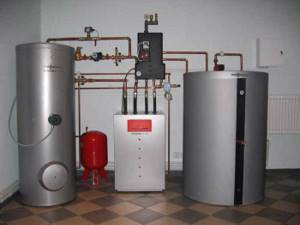
You can calculate gas consumption for heating a house using the design capacity of the boiler
Next, add 10% for the imperfection of the boiler, we find that for this case the consumption will be slightly more than 1000 cubic meters per month (1029.3 cubic meters). As you can see, in this case everything is even simpler - fewer numbers, but the principle is the same.
By quadrature
Even more approximate calculations can be obtained based on the square footage of the house. There are two ways:
- You can calculate according to SNiP standards - on average, heating one square meter in Central Russia requires 80 W/m2. This figure can be used if your house is built according to all requirements and has good insulation.
- You can estimate based on average statistical data: with good insulation of the house, 2.5-3 cubic meters/m2 is required;
- with average insulation, gas consumption is 4-5 cubic meters/m2.
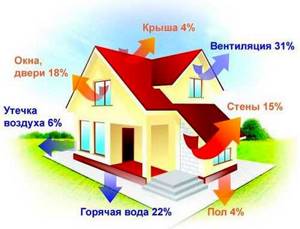
The better the house is insulated, the lower the gas consumption for heating will be.
Each owner can assess the degree of insulation of his home; accordingly, one can estimate what gas consumption will be in this case. For example, for a house of 100 sq. m. with average insulation, 400-500 cubic meters of gas will be required for heating, for a house of 150 square meters it will take 600-750 cubic meters per month, for heating a house with an area of 200 m2 - 800-100 cubic meters of blue fuel. All this is very approximate, but the figures are derived based on many factual data.
How to convert kW to Gcal/h
Key indicator for converting data from kilowatts to calories:
1 kW = 0.00086 Gcal/hour
To find out how many Gcal is obtained, you need to multiply the available number of kW by a constant value, 0.00086.
Let's look at an example. Suppose you need to convert 250 kW into calories.
250 kW x 0.00086 = 0.215 Gcal/hour.
(More accurate online calculators will show 0.214961).
To ensure 100% reliability of the heating system, a good solution would be to install an electric boiler along with a solid fuel boiler. It is quite possible to assemble such a structure with your own hands and thereby save money.
Instructions for assembling an electrolyzer with your own hands are presented here.
The heating season has arrived, but the radiators are still cold? Don’t look for ways to warm yourself, demand respect for your rights. Follow the link for information on where to call and what to do if there is no heating.
